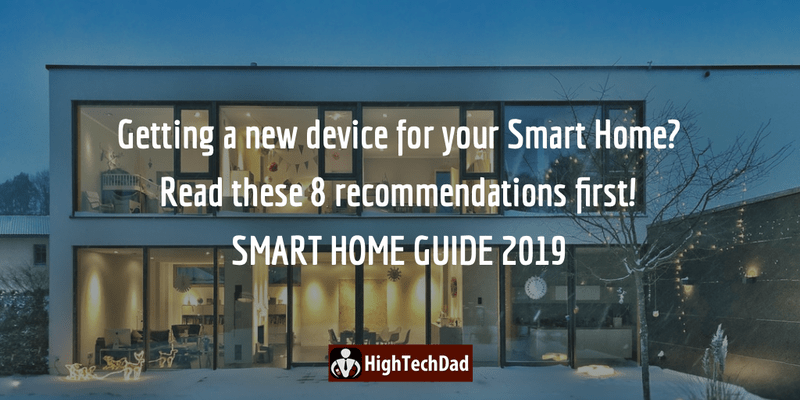Making your home “smart” or automated is all the rage right now. There are hubs galore, smart sensors and lights, speakers that respond to your voice, thermostats that regulate your home’s comfort level, blinds that raise and lower automatically…the list goes on and on. And, it seems like every day, new devices come on the market which claim to simplify your life with some new type of automation or set of smart features. But before you rush out and get the latest and greatest smart home tech, read through this list of things you should think about when buying a smart home device.
I have reviewed quite many smart home gadgets over the past years, and have compiled several ideas on what to look for when purchasing these types of devices. This list is not definitive by any means, so you are welcome to discard any of my recommendations. But, I have discovered through my years of testing, that there are certain things that I like or don’t when it comes to automating your home.
There is something to be said about instant gratification when it comes to a smart gadget. I know that I’m frequently a victim of wanting the latest bright and shiny device as soon as I learn about it. But, if you take a few minutes of “calm” before pulling the trigger on that gadget, you may benefit in the long run.
Update 4/1/19: (Not an April Fool’s Day joke) – I created a 20-minute video that covers much of the information contained within this article as well as some other tips and advice.
Here’s my shortlist of things to consider when buying a smart home device:
- Do you understand the company’s privacy policy?
- Extensibility: Is the gadget a one-use or a multi-use product?
- What is the viability of the company?
- What type of price point does the gadget have?
- Have you checked end-user reviews?
- Does the device actually offer a solution for you or are you embracing a solution?
- What type of pricing model does the smart device have?
- Is the smart device part of an ecosystem or just a standalone device?
The rest of this article goes into a bit more detail on each of these points. But before I dive in, I want to ask, what are the requirements that you have when shopping for a smart home device? Leave a comment and share your thoughts!
Do You Understand the Company’s Privacy Policy?
This is actually quite a loaded question and one that could warrant a standalone article as it is so critical to consider. And, I’m putting it first on the list so that I’m sure you at least scan through it.
There have been many, many articles about personally identifiable information (PII) and data privacy when it comes to devices. Smart speakers, for example, are “always listening” to your conversations, but supposedly not interacting with that voice data until the smart speaker keyword is uttered. Then they go into action. All the major smart speaker companies claim that they are not storing or recording those conversations, but honestly, you never truly know.
And, if you are purchasing a one-off smart speaker that isn’t using Google, Apple, Amazon, or Microsoft, how sure can you truly be assured that all of your conversations or videos aren’t being stored and analyzed. Cybercity has a nice little roundupof some of the leading virtual assistants and the data they collect. Even the American Bar Association weighs in on voice-controlled systems and the recorded data.
So yes, for whatever smart device you choose, you should do some privacy research. Look at the company’s privacy policy. Understand their data retention policy as well as how that data is used?
Is it anonymized? That is to say, can the data captured from a device but used to identify you personally?
Back in 2017, I wrote two sponsored articles that discussed holiday toys that may have the capability of “spying” on you. Mozilla actually developed a service that looked at a few popular toys during the holiday season and evaluated many of these privacy concerns. See post #1 and post #2 for more details.
Bottom line here, do some research to understand better how that smart home device is using your data, if you can ask them to delete that data if you no longer use the device, and what other protections you have as a consumer.
Extensibility: Is the Smart Gadget a Single-Use or Multi-Use Product?
This question is a bit of a catch-22. On one side, you want to be sure that the smart device you are considering buying is an industry leader and know what they are doing. But on the flip side, if the device is suitable for just one single thing, what happens when something better comes on the market (and it will, most definitely).
It is a bit of a conundrum.
Say, for example, you get a smart light switch. (And this is from personal experience.) The smart switch connects to a smart hub or directly to a proprietary app (which, in my opinion, is worse). That smart switch is only as good as that single use: turning on or off and being controlled remotely.
But let’s say you get a different smart switch that actually has more “smarts” built into it. In fact, it doesn’t need a hub to connect to as it has one built-in. This is much more extensible. But, more things can go wrong, and that particular smart device can be more complex (or pricey).
I offer the following example: printers. Nowadays, you can purchase AIO (All In One) printers that have printing, scanning, and faxing capabilities. These are great as you essentially get three devices built into one. They are less expensive than buying each function separately, and they take up less space. But, if one of the devices “goes bad” then suddenly you have a two-in-one or single-use device. Do you buy a single use device then? Or just scrap the AIO entirely and get a new one?
In the example above, a dedicated, single-use device might be more advantageous. But it really depends on the problem you are trying to solve.
Personally, I feel that when it comes to smart devices, having multiple functions is actually advantageous, assuming that those functions are NOT proprietary and unique to only a closed ecosystem.
So when you choose that smart device, be sure to understand if it is:
- a closed ecosystem
- single or multi-use
- open to other types of integrations
One more example here: I was recently asked what type of baby cam I would recommend. As the tech I review tends to follow fairly closely to the age of my daughters, the “baby cam days” were quite a few years ago. So I didn’t really have anything to say about baby cams. What I DID have to say, however, was around getting something that was a bit more extensible and could grow with your family. So I recommended getting a security camera instead. Modern security cameras have many of the same features as baby cams (two-way audio, night vision, storage, remote viewing, smartphone app) but they may be made a bit better and can be used in the future.
Remember, a garage door opener might only be single use, but if it hooks into a larger ecosystem (e.g., alarm system, smart hub with notification, controlled by geolocation, etc.) it might be more useful than one that doesn’t have those capabilities.
What Is the Viability of the Company?
This is always tricky to assess. Marketing teams of companies will put their best foot forward to try to convince you that they are the leader, that they are here to stay, and that their smart product will leave the competition in the dust.
Until they aren’t the leader, disappear, or the competition crushes them.
So how do you ensure that you are choosing a reputable company that will stick around?
For starters, go with a name that you know.
Second, do a quick Google search on the company to understand their news cycle. Is there anything that jumps out at you? Look for things like:
- Lots of press releases and then going silent – could mean some internal issues or just a lack of innovation
- Negative reviews – see my point later on about this
- Have they been acquired? Will the acquiring company allow them to continue or kill them?
- Have they recently gotten more funding – this could be good or bad, they may be hemorrhaging money or actually crushing the market
- Is there no news at all? Might want to look somewhere else
- Is the competition popping up more? The competition may have a lot of marketing dollars (or a better product)
I always say, check the company blog. Are they posting regularly? Is what they are posting innovative information or just fluff? You can really learn a lot about a company from the type of content they produce.
Do they frequently update their product? Most smart devices can be upgraded via software or firmware to fix issues, increase security, or even add features. Does the device you want get regular updates? Can you find and review the Release Notes?
Look into the company’s support process. Do they post regular support hours? How do you contact them? Phone? Email? Chat? You may even want to try a support request like “is XXX product compatible with YYY?” and see how long it takes them to respond or if they respond at all.
All of these little “tests” will help you assess the viability of the company.
What Type of Price Point Does the Gadget Have?
There are two ends to the spectrum here: cheap and expensive. I’m going to go out on a limb here and say that you need to hit that sweet spot of right in the middle for that particular gadget type. If you go too cheap, the product will most likely be…yeah, cheap (e.g., poorly manufactured).
Cheap products break which means they were probably poorly designed in the first place. If, for example, a smart light switch only costs like $10, I would stay away. You don’t know how they are manufactured or if they even followed safety designs in manufacturing.
Alternatively, if something is super expensive, you might be just throwing your money out into the street. Case in point, I have a very expensive smart air purifying fan that I have had for over a year, but I have not reviewed it because there is an issue with its WiFi compatibility with the WiFi router I have. If I had paid the high price, it would have been returned by now. My point here is that even the costly items break, and when they do, fixing them can be even more expensive.
Just think about high-end sports cars…
So again, find a price point that isn’t too low or too high for the type of gadget.
Have You Checked End-User Reviews?
Most of us nowadays buy gadgets online (unless you are an instant gratification type of person where you will race out to your local electronics warehouse and pay a premium). The beauty of buying online is that on most sites, you can read “user reviews.” I put that in quotes because you do have to be careful about those “verified purchase” type of reviews as they may not be legit or the reviewer may have been compensated to write the review.
Reviews on Amazon are usually an ok way to get an overall rating of the smart product. BUT I would recommend also looking at the number of ratings/reviews and start by reading the negative reviews first. More ratings tend to have a more accurate score – it’s the law of averages.
But don’t just look at star ratings. As I mentioned, I like looking at the negatives or “cons” first. People tend to go into detail about the stuff they DON’T like. If you only look at the positives or “pros,” you will see things like “works great” or “fantastic product” without many details. And, unfortunately, some of those short, 5-star ratings are fake or paid for.
Do a search for the product and add “review” to the end of the name. You will hopefully get some reputable results or at least some results by sites that are really good at SEO (Search Engine Optimization). Heck, you may even find one of my reviews! For smart devices, there are lots of reputable sites that review them.
Just be sure to research a bit and read user reviews and a few site reviews. With that, you will probably have a better idea as to if that smart home device is indeed a smart or dumb idea.
Does the Device Actually Offer a Solution for You or Are You Embracing a Solution?
I call this the Steve Jobs effect. Steve Jobs was a master at convincing us that we had a hole in our lives, one that we previously didn’t know we had, and that he had the “one more thing” to fill it. Think about the introduction of the iPhone in 2007. Up until that point, cellphones had keyboards for numbers and letters. The iPhone introduced something new, a purely touchscreen phone without any type of keyboard.
Did you, prior to that point, realize you wanted a phone without a keyboard? Probably not. But Steve convinced us that we did. (And when you look back now, he seems to have been correct.)
A good marketer or salesperson can convince you that you really want or need something. The only reason I mention this is because it is all too easy to fall into the trap of being convinced that you MUST have a particular smart home device (or any gadget for that matter), without clearly evaluating whether you want the device or truly need it.
If your life won’t function without the smart gadget, you probably need it.
If your front door is without a lock, you need to put a lock on it. And, if you have the option of putting a smart lock on it, you will probably want to do that.
But think about the smart lock solutions – perhaps you truly need to have a smart lock. Do you want to be notified when your kids come into your home? A smart lock can send notifications. Do you need to create temporary passcodes for workers, babysitters, or cleaners, you probably need a smart lock.
In the case above, it’s a pretty easy shift from just wantinga smart lock to actually needinga smart lock because of all of the use cases specific to you.
I often find that I’m able to evolve a “want” into a “need” over time, as I convince myself and those around me that I actually can’t survive without this home automation solution. My advice to you here is to honestly evaluate your wants versus needs and understand the use case(s) you are trying to solve. You may not need the solution, or you may need a different one. Or, the smart device you have chosen may be perfect in the end.
What Type of Pricing Model Does the Smart Device Have?
Before you purchase your smart device, be sure to understand the pricing model. Some devices you pay a flat fee. With others, you may pay for the device and then pay a monthly or yearly service fee. The most straightforward example to understand here is that of a smart security camera.
You purchase the hardware, usually the camera and perhaps a hub for a flat price. Then you are presented with some options for storage or other smart features (like face detection). Many companies are shifting their revenue streams toward recurring subscription models where you sign up for their enhanced service by month or year. While there are often free tiers, frequently those don’t have the “really cool” features that you will probably want (or need).
The subscription model is like the razor versus razor-blade scenario. You get the fancy razor for cheap, but then you are hooked into buying proprietary razor blades for the rest of the life of the razor.
While not all smart home devices have subscription models, any time a device requires cloud storage or enhanced functionality driven by Machine Learning (ML) or Artificial Intelligence (AI), you can bet there is probably a service or subscription plan to go with it.
Also, be wary of subscriptions that aren’t immediately apparent. Larger companies (think Amazon, Google, and Apple) will sell you devices (again, think about smart speakers that have virtual assistants built in) at a reasonable price just to hook you into their ecosystem. (See the next section.)
Is the Smart Device Part of an Ecosystem or Just a Standalone Device?
As I alluded to in the previous section, many of the larger companies that have ecosystems tied to their smart products use some devices to get you into their systems. With the Apple smart speaker, they assume you will want to play music so you may get hooked into subscribing to an Apple Music plan. Similarly, if you are part of the Google Home ecosystem, you may start to pay subscription plans for music, movies, or home security video monitoring. And with Amazon, the Alexa service will make you want to consider becoming an Amazon Prime member among other things.
While joining an ecosystem may be a good thing for many people (think easier integrations and more seamless offerings), don’t rule out stand-alone solutions as well. Plenty of smart devices will integrate with these other ecosystems, allowing you to still have the full control but with additional features.
For example, I have a smart wall switch that has Amazon Alexa integration. So while the smart switch controls the lights it is connected to (as well as control other of its own networked switches), I can use Alexa to control other smart devices within my home. And, this switch integrates with other standalone services for smart speakers, thermostats, and security cameras.
So it is crucial to evaluate keeping things within the same ecosystem OR choosing a smart device that has deep and growing integrations with other smart devices or ecosystems.
Are You Making the “Smart” Decision?
There are probably other factors that weigh into your smart home device purchase decision. The eight items that I outlined should be a good starting point for you. And yes, it is quite a lot to think about. But as you build out your home automation or smart home, it is critical to think through these decisions, whether you are adding to your smart home’s infrastructure or just starting from scratch.
But I’m curious. What other factors weigh into your decision-making process? How do you choose what is right for your home? Do any of the items I outlined above factor into what you do or do not purchase? Please leave a comment and let me know what factors affect your move towards the perfect smart home or one that is just sort of “meh.”
Also, I have reviewed numerous smart home devices and gadgets so be sure to browse around some of my articles on this topic of smart homes.
Remember, making informed decisions about your smart home can make your home experiential versus just feel like being bolted on. And with more technology and devices entering the market daily, as well as upgrades to existing devices happening regularly, your smart home will only become more intelligent and more integrated, again, assuming you make the right choices.
HTD says: This Smart Home Guide is designed to help you employ some critical thinking when purchasing a new connected or smart device. Making the wrong choice without research can actually make your home dumber. So choose those smart gadgets wisely!


![Smart Home Guide 2019: Before Buying that Smart Home Device, Check These 8 Things First [Updated] 1 HighTechDad's Smart Home Guide 2019 - before buying that smart device, check these 8 things first!](https://www.hightechdad.com/wp-content/uploads/2019/03/HTD-smart-home-guide-2019-title.png)
![Smart Home Guide 2019: Before Buying that Smart Home Device, Check These 8 Things First [Updated] 2 HighTechDad's Smart Home Guide 2019 - Do you understand the company's privacy policy?](https://www.hightechdad.com/wp-content/uploads/2019/03/HTD-smart-home-guide-privacy-policy.png)
![Smart Home Guide 2019: Before Buying that Smart Home Device, Check These 8 Things First [Updated] 3 HighTechDad's Smart Home Guide 2019 - is the product single or multi-use?](https://www.hightechdad.com/wp-content/uploads/2019/03/HTD-smart-home-guide-extensibility.png)
![Smart Home Guide 2019: Before Buying that Smart Home Device, Check These 8 Things First [Updated] 4 HighTechDad's Smart Home Guide 2019 - what is the viability of the company?](https://www.hightechdad.com/wp-content/uploads/2019/03/HTD-smart-home-guide-viability.png)
![Smart Home Guide 2019: Before Buying that Smart Home Device, Check These 8 Things First [Updated] 5 HighTechDad's Smart Home Guide 2019 - what type of price point does the gadget have?](https://www.hightechdad.com/wp-content/uploads/2019/03/HTD-smart-home-guide-pricepoint.png)
![Smart Home Guide 2019: Before Buying that Smart Home Device, Check These 8 Things First [Updated] 6 HighTechDad's Smart Home Guide 2019 - have you checked end-user reviews?](https://www.hightechdad.com/wp-content/uploads/2019/03/HTD-smart-home-guide-enduser-reviews.png)
![Smart Home Guide 2019: Before Buying that Smart Home Device, Check These 8 Things First [Updated] 7 HighTechDad's Smart Home Guide 2019 - does the device actually offer a solution for you or are you embracing a solution?](https://www.hightechdad.com/wp-content/uploads/2019/03/HTD-smart-home-guide-solution.png)
![Smart Home Guide 2019: Before Buying that Smart Home Device, Check These 8 Things First [Updated] 8 HighTechDad's Smart Home Guide 2019 - what type of pricing model does the smart device have?](https://www.hightechdad.com/wp-content/uploads/2019/03/HTD-smart-home-guide-pricing-model-razor.png)
![Smart Home Guide 2019: Before Buying that Smart Home Device, Check These 8 Things First [Updated] 9 HighTechDad's Smart Home Guide 2019 - is the smart device part of an ecosystem or just a standalone device?](https://www.hightechdad.com/wp-content/uploads/2019/03/HTD-smart-home-guide-ecosystem.jpg)







1 Response
AMAZING!!! Thank you so much for sharing about smart home technology! It’s a Genius!!! it makes life more comfortable by giving you smart control over the things you use every day.